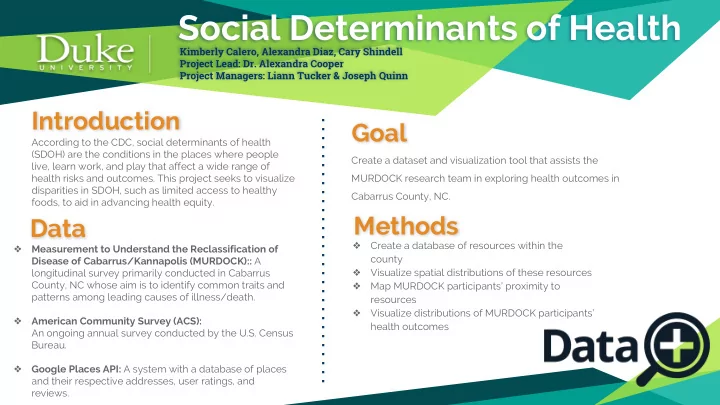

Social Determinants of Health Kimberly Calero, Alexandra Diaz, Cary Shindell Project Lead: Dr. Alexandra Cooper Project Managers: Liann Tucker & Joseph Quinn Introduction Goal According to the CDC, social determinants of health (SDOH) are the conditions in the places where people Create a dataset and visualization tool that assists the live, learn work, and play that affect a wide range of health risks and outcomes. This project seeks to visualize MURDOCK research team in exploring health outcomes in disparities in SDOH, such as limited access to healthy Cabarrus County, NC. foods, to aid in advancing health equity. Methods Data Create a database of resources within the ❖ ❖ Measurement to Understand the Reclassification of county Disease of Cabarrus/Kannapolis (MURDOCK):: A Visualize spatial distributions of these resources longitudinal survey primarily conducted in Cabarrus ❖ County, NC whose aim is to identify common traits and Map MURDOCK participants’ proximity to ❖ patterns among leading causes of illness/death. resources Visualize distributions of MURDOCK participants’ ❖ ❖ American Community Survey (ACS): health outcomes An ongoing annual survey conducted by the U.S. Census Bureau. ❖ Google Places API: A system with a database of places and their respective addresses, user ratings, and reviews.
Social Determinants of Health Phase I: Database Creation Phase II: Resource Distribution A database of the resources within Cabarrus County Using data from the ACS and the database compiled in Phase I, we was compiled using Yelp and Google Places’ API. There created an interactive mapping application using R Leaflet and Shiny were 17 categories for the resources compiled, ranging packages that provide a visual distribution of resources within from grocery stores and schools, to Starbucks locations Cabarrus county. and vape stores. Users can toggle which underlying demographic from the ACS and Each entry was then flagged using a binary system resource from the database they want to view. based on which categories the entry belonged to. This was done to facilitate efficient subsetting of the data. Figure 1: An image of the tool, Table 1: An example of how the database is organized currently showing the and the information it contains. distribution of total population in the county id name rating rev. lat / add. sourc cat. cat. cat. by census tract, overlaid count lon. e 1 2 3 by grocery store locations. 12 ABC 4.2 97 x,y add. Yelp 0 1 0 1 34 XYZ 3.1 6 x,y add. Googl 0 0 1 2 e
Social Determinants of Health Phase III: Determine Proximity Next Steps: Voronoi mapping was used to determine which resource was closest to each address. Each polygon represents a resource’s region of influence. The dots represents the location of the resource 1. Determine MURDOCK participants’ proximity to all of the itself. The polygons, voronoi cells, indicate the resource the resources compiled in Phase I. addressee is most likely going to use. 2. Map the distribution of health outcomes in Cabarrus county, such as prevalence of diabetes, heart disease, and Figure 2: depression. A voronoi diagram of grocery stores, clipped to the Acknowledgments: shape of Cabarrus county. Our team would like to thank our Project Managers, Joe Quinn and Liann Tucker for working closely with us throughout the Using Google’s API, the driving/walking time and distance summer. We would also like to thank our Project Lead, Dr. from an addressee to their closest resource was determined. Alexandra Cooper, for her ongoing support. A special thank you to Paul Bendich for giving our team the idea to use Voronoi Mapping Table 1 : A database ADD ID MI TO R1 MIN TO R1 MI TO R2 TIME TO R2 as part of Phase III of this project and for his continued support to of addresses and the Data+ program. Thank you to the MURDOCK team for your their respective 43428 4.3 15 2.4 7 collaboration and guidance. distances to two types of resources. 42349 3.7 10 1.8 5
Recommend
More recommend